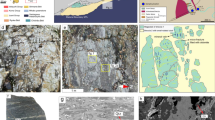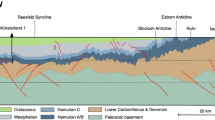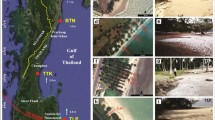Abstract
The distinctive bathymetric feature exists in the Suruga Bay, Japan. It has been called as Senoumi (Stone flower sea) from old times. Senoumi is a 30 km wide and 20 km long concave feature. Its origin has not been explained yet; however, the feature might be a combined consequence of intensive tectonic activity in the plate border, landslides, and a submarine flow coming from the Oi River. If the Senoumi was caused by a landslide, the latter would be larger than any on-land landslide in Japan. The downshelf “exit” from this feature is much narrower than its central part. This is not usual shape of landslides, but it is similar to the liquefied landslides such as those in quick clays which mobilize great strength reduction after failure. To study Senoumi as a landslide, the shear behaviors of the following three soil samples were investigated by the cyclic and seismic undrained stress control ring shear tests. One sample is volcanic ash taken from the base of landslide deposits (mass transport deposits), from 130 to 190 m deep layer below the submarine floor which was drilled and cored by the Integrated Ocean Drilling Program Expedition 333. Another two samples are the Neogene silty–sand and silt taken from the Omaezaki hill adjacent to the Senoumi, because the shear zone might have been formed in Neogene layers extending from on-land to the continental shelf. The largest strength reduction from peak to steady-state shear resistance in the undrained cyclic loading test was found in volcanic ash. The strength reduction in Neogene silty–sand was smaller than volcanic ash, while the Neogene silt mobilized the least post-failure strength reduction. An integrated model simulating the initiation and motion of earthquake-induced rapid landslides (landslide simulation (LS)-RAPID, Sassa et al. Landslides 7–3:219–236, 2010) was applied to this study. The steady-state shear resistance and other geotechnical parameters measured by the undrained ring shear tests and the greatest strong motion record in the 2011 off-the-Pacific Coast of Tohoku earthquake (M w 9.0), also known as “2011 Tohoku Earthquake” at the observation point MYG004 (2,933 gal) were input to this model. As the result, it was found that landslides would be triggered by 0.30–1.0 times of MYG004 in volcanic ash, 0.4–1.0 times of MYG004 in Neogene silty–sand and Neogene silt, though the depth and area of triggered landslides were different in soils and intensity of shaking. Feature, created by LS-RAPID using the parameters of volcanic ash, was most similar to the Senoumi in depth and extent. The result obtained from this study includes a hypothesis to be proved, but presents the strong need to investigate the risk of the large-scale submarine landslides which could enhance tsunami wave and possibly enlarge the submarine landslide retrogressively into the adjacent coastal plain by the upcoming mega earthquake in the Nankai Trough.



















Similar content being viewed by others
References
Abe I, Goto K, Imamura F, Shimizu K (2008) Numerical simulation of the tsunami generated by the 2007 Noto Hanto Earthquake and implications for unusual tidal surges observed in Toyama Bay. Earth Planets Space 60:133–138
Ando M (1975) Source mechanisms and tectonic significance of historical earthquakes along the Nankai Trough, Japan. Tectonophysics 27:119–140
Baba T, Matsumoto H, Kashiwase K, Hyakudome T, Kaneda Y, Sano M (2011) Micro-bathymetric evidence for the effect of submarine mass movement on tsunami generation during the 2009 Suruga bay earthquake, Japan. In: Yamada et al. (eds.). Submarine mass movements and their consequences. Advances in Natural and Technological Hazards Research 31. Springer: New York. pp. 485–494
Bondevik S, Mangerud J, Dawson S, Dawson A, Lohne P (2005) Evidence for three North Sea tsunamis at the Shetland Islands between 8,000 and 1,500 years ago. Quat Sci Rev 24:1757–1775
Cabinet Office of the Government of Japan (Committee on megaquake model in Nankai Trough) (2011) Intermediate report of the study team for the Mega-quake model in Nankai trough. http://www.bousai.go.jp/jishin/chubou/nankai_trough/chukan_matome.pdf
Cabinet office of the Government of Japan (Committee on Megaquake Model in Nankai Trough)(2012) The tsunami-fault model in the 2011 off the Pacific Coast of 2011 Tohoku Earthquake, Reference No. 1 of the 12th Meeting of Megaquake Model in Nankai Trough. http://www.bousai.go.jp/jishin/chubou/nankai_trough/12/sub_1.pdf
Cochonat P, Cadet J, Lallemant S, Mazzotti S, Nouze H, Fouchet C, Foucher J (2002) Slope instabilities and gravity processes in fluid migration and tectonically active environment in the eastern Nankai accretionary wedge (KAIKO-Tokai’ 96 cruise). Mar Geol 187:193–202
Expedition 333 Scientists (2012) Site C0018. In: Henry P, Kanamatsu T, Moe K, and the Expedition 333 Scientists, Proc. IODP, 333: Tokyo (Integrated Ocean Drilling Program Management International, Inc.). DOI:10.2204/iodp.proc.333.103.2012
Fine I, Rabinovich A, Bornhold B, Thomson R, Kulikov E (2005) The Grand Banks landslide-generated tsunami of November 18, 1929: preliminary analysis and numerical modelling. Mar Geol 215:45–57
Hayashida A, Kamata H, Danhara T (1996) Correlation of widespread tephra deposits based on paleomagnetic directions: link between a volcanic field and sedimentary sequences in Japan. Quat Int 34–36:89–98
Japan Landslide Society (1996) Landslides in Japan, 5th edn
Kajiura K (1963) The leading wave of a tsunami. Bull Earthquake Res Inst Univ Tokyo 41:545–571
Kishimoto K (2000) Combined bathymetric and topographic mesh data: Japan 250 m.grd. Geological Survey of Japan. GSJ open-file report no. 353
Locat J, Lee H (2008) Submarine mass movement and their consequences: an over view. In: Sassa K, Canuti P (eds) Landslides—disaster risk reduction. Springer, New York, pp 115–142
Sassa K, Fukuoka H, Wang G, Ishikawa N (2004) Undrained dynamic-loading ring-shear apparatus and its application to landslide dynamics. Landslides 1–1:7–19
Sassa K, Fukuoka H, Wang F, Wang G (2005) Dynamic properties of earthquake-induced large-scale rapid landslides within past landslide mass. Landslides 2–2:125–134
Sassa K, Nagai O, Solidum R, Yamazaki Y, Ohta H (2010) An integrated model simulating the initiation and motion of earthquake and rain induced rapid landslides and its application to the 2006 Leyte landslide. Landslides 7–3:219–236
Satake K (2001) Tsunami modeling from submarine landslides. Proceedings of the International Tsunami Symposium, 665–674
Sato H, Sekiguchi T, Kojiroi R, Suzuki Y, Iida M (2005) Overlying landslides distribution on the earthquake source, geological and topographical data: the Mid Niigata prefecture earthquake in 2004. Landslides 2–2:143–152
Strasser M, Moore, G, Kimura G, Kopf A, Underwwd M, Guo J, Screaton E (2011) Slumping and mass transport deposition in the Nankai fore arc: Evidence from IODP drilling and 3-D reflection seismic data. Geochem Geophys Geosyst 12, Q0AD13. DOI: 10.1029/2010GC003431
Strasser M, Henry P, Kanamatsu T, Thu M, Moore G, IODP Expedition Scientists (2012) Scientific drilling of mass-transport deposits in the Nankai accretionary wedge: first result of from IODP Expedition 333. Submarine mass movements and their consequences, Advances in Natural and Technological Hazards Research 31 (eds. Yamada et al.). New York: Springer, 671–681
Synolakis C, Bardet J, Borrero J, Davies H, Okal E, Silver E, Sweet S, Tappin D (2002) The slump origin of the 1998 Papua New Guinea tsunami. Proc R Soc Lond A Math Phys Eng Sci 458:763–789
Tappin D, Watts P, Grilli S (2008) The Papua New Gunea tsunami of 17 July 1998: anatomy of a catastrophic event. Nat Hazard Earth Syst Sci 8:243–266
Trandafir A, Sassa K (2005) Seismic triggering of catastrophic failures on shear surfaces in saturated cohesionless soils. Can Geotech J 42:229–251
Tsuchi R (2001) Geomorphology and geology of Shizuoka Prefecture—geology of Shizuoka Prefecture (2001 Revision version) with explanation. Naigai Map Co. Ltd. One map, pp 92
Acknowledgments
We acknowledge the SATREPS of the Government of Japan and two projects of the International Programme on Landslides which is a joint program of ICL and ICL supporting organizations, IPL-157 Dynamics of sub-aerial and submarine megaslides (leader, Kyoji Sassa) and IPL-161 Risk identification and land-use planning for disaster mitigation of landslides and floods in Croatia (leader, Hideaki Marui). R. Urgeles of the Institut de Ciències del Mar, Spain for information on marine landslides and T. Furumura of the Center for Integrated Disaster Information Research, the University of Tokyo for consultation on earthquake shaking are appreciated. The authors thank the research and technical cooperation from Y. Kaneda, M. Yasunaga as well as the ship and personnel of the Drilling Vessel Chikyu of the Japan Agency for Marine-Earth Science and Technology. Thanks go to Croatian young researchers of Rijeka University to support experiments during their stay in Japan. This research used samples and data provided by the Integrated Ocean Drilling Program (IODP), and used the combined bathymetric and topographic mesh data of the Geological Survey of Japan.
Author information
Authors and Affiliations
Corresponding author
Rights and permissions
About this article
Cite this article
Sassa, K., He, B., Miyagi, T. et al. A hypothesis of the Senoumi submarine megaslide in Suruga Bay in Japan—based on the undrained dynamic-loading ring shear tests and computer simulation. Landslides 9, 439–455 (2012). https://doi.org/10.1007/s10346-012-0356-2
Received:
Accepted:
Published:
Issue Date:
DOI: https://doi.org/10.1007/s10346-012-0356-2




